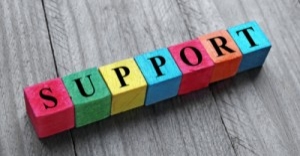On 30 March 2020, the Federal Government announced the introduction of the JobKeeper Payment package.
This assistance aims to help businesses including early childhood services to keep Educators in their jobs and re-start when the crisis is over. For employees, including Educators, this means you can keep your job and earn an income – even if hours have been cut.
An amount of $1,500 per eligible employee (before PAYG tax) can be claimed each fortnight from 30 March 2020 to at most 30 September 2020 (ie a maximum of 6 months).
Which employers are eligible?
Any employer whose business has a turnover of less than $1 billion and their turnover will be reduced by more than 30% relative to a comparable period a year ago (of at least a month); or
Any employer whose business has a turnover of $1 billion or more and their turnover will be reduced by more than 50% relative to a comparable period a year ago (of at least a month); and
- The business is not subject to the Major Bank Levy.
- The employer must have been in an employment relationship with eligible employees as at 1 March 2020, and confirm that each eligible employee is currently engaged in order to receive JobKeeper Payments.
Not-for-profit entities (including charities) and self-employed individuals (businesses without employees), that meet these turnover tests that apply for businesses, are eligible to apply for JobKeeper Payments.
Which employees are eligible?
Subject to the above about employers, all of the following must apply:
An employee who is currently employed by the (above mentioned) eligible employer (including those stood down or re-hired) who was:
- employed by the employer as at 1 March 2020;
- employed as full-time, part-time, or long-term casuals (a casual employed on a regular basis for longer than 12 months as at 1 March 2020);
- An employee who is at least 16 years of age;
An employee who is an Australian citizen, the holder of a permanent visa, a Protected Special Category Visa Holder, a non-protected Special Category Visa Holder who has been residing continually in Australia for 10 years or more, or a Special Category (Subclass 444) Visa Holder; and
An employee who is not in receipt of a JobKeeper Payment from another employer.
(NOTE: If your employees receive the JobKeeper Payment, this may affect their eligibility for payments from Services Australia as they must report their JobKeeper Payment as income.)
How do you apply?
Eligible early childhood education and care service providers can register via the Australian Taxation Office (ATO)'s JobKeeper registration page.
The ATO will then use Single Touch Payroll to pre-populate all of the eligible employees' data for processing.
Eligible employers will still need to identify eligible employees for JobKeeper Payments and must provide monthly updates to the ATO.
Does the employer need to pay the employees' superannuation on the JobKeeper Payments?
It will be up to the employer if they want to pay superannuation on any additional wage paid because of the JobKeeper Payment.
When will employees begin receiving the JobKeeper Payments?
At the earliest, the JobKeeper Payments will be distributed to employers from the ATO in the first week of May 2020.
Please note that JobKeeper Payments will be received before PAYG tax.
In other words, the JobKeeper Payments will be received by employers each month in arrears.
What if the eligible employee ordinarily earns less than $1,500 per fortnight?
If an employee ordinarily receives less than $1,500 in income per fortnight before tax, their employer must pay their employee, at a minimum, $1,500 per fortnight, before tax.
What if the employee's employment had ceased after 1 March 2020?
If an employee was employed on 1 March 2020, subsequently ceased employment with their employer, and then has been re-engaged by the same eligible employer, the employee will receive, at a minimum, $1,500 per fortnight, before tax.
How will the employees know in advance if they will be receiving JobKeeper Payments?
The employer must advise employees after the employer has confirmed her/his identification of eligible employees to the ATO.
Can employees receive more than one JobKeeper Payment from different employers?
No. There can only be one JobKeeper Payment via one employer.
EXAMPLE: Employer with employees on different wages
Susan owns and operates an early childhood education and care service with two employees. The service is still operating at this stage but Susan's service has experienced a decline in attendances and therefore revenue of more than 30% for the month of March 2020 (when compared to March 2019).
The employees are:
Anne, who is a permanent full-time employee on a salary of $3,000 per fortnight before tax and who continues working for the service; and
Nicole, who is a permanent part-time employee on a salary of $1,000 per fortnight before tax and who continues working for the service.
Susan's service is eligible to receive the JobKeeper Payment for each employee, which would have the following benefits for the service and its employees:
The service continues to pay Anne her full-time salary of $3,000 per fortnight before tax, and the service will receive $1,500 per fortnight from the JobKeeper Payment to subsidise the cost of Anne’s salary and will continue paying the superannuation guarantee on Anne’s income;
The service continues to pay Nicole her $1,000 per fortnight before tax salary and an additional $500 per fortnight before tax, totalling $1,500 per fortnight before tax. The service receives $1,500 per fortnight before tax from the JobKeeper Payment which will subsidise the cost of Nicole's salary. The service must continue to pay the superannuation guarantee on the $1,000 per fortnight of wages that Nicole is earning. The service has the option of choosing to pay superannuation on the additional $500 (before tax) paid to Nicole under the JobKeeper Payment.
Susan can register her initial interest in the scheme from 30 March 2020, followed subsequently by an application to ATO with details about her eligible employees. In addition, Susan is required to advise her employees that she has nominated them as eligible employees to receive the payment. Susan will provide information to the ATO on a monthly basis and receive the payment monthly in arrears.
EXAMPLE: Employer with employees who have been stood down without pay
Zoe runs an early childhood education and care service. Ordinarily, she employs three permanent part-time staff, but the governments' policies and public statements have rendered her service with critically low attendances of children to the point of non-viability. She and her three employees have mutually agreed to take leave.
Zoe’s turnover has declined by more than 30% in March 2020 (compared to March 2019), so she is eligible to apply for the JobKeeper Payment for each employee, and pass on $1,500 per fortnight before tax to each of her three employees for up to six months. Zoe will maintain the connection to her employees, and be in a position to quickly resume her operations.
Zoe is required to advise her employees that she has nominated them as eligible employees to receive the payment. It is up to Zoe whether she wants to pay superannuation on the additional income paid because of the JobKeeper Payment.
If Zoe's employees have already started receiving income support payments like the JobSeeker Payment when they receive the JobKeeper Payment, they will need to advise Services Australia of their new income.
Reference:
Sourced from "Coronavirus - Government Announces JobKeeper Payment Package (Wage Subsidy)", Australian Childcare Alliance, 31 March 2020



 On 10 December 2025, the Fair Work Commission issued a major determination affecting the Children’s Services Award 2010 (MA000120). These changes form part of the
On 10 December 2025, the Fair Work Commission issued a major determination affecting the Children’s Services Award 2010 (MA000120). These changes form part of the Over the next five years, educators across the sector will see steady, structured wage increases designed to lift pay to the new benchmark rates for
Over the next five years, educators across the sector will see steady, structured wage increases designed to lift pay to the new benchmark rates for The Fair Work Commission has introduced important changes to how cooks are classified and paid under the Children’s Services Award 2010. These changes recognise that
The Fair Work Commission has introduced important changes to how cooks are classified and paid under the Children’s Services Award 2010. These changes recognise that At the centre of this case is an incident captured on CCTV at an early learning service in Bathurst, where 18‑year‑old educator Hayley Kelleher grabbed
At the centre of this case is an incident captured on CCTV at an early learning service in Bathurst, where 18‑year‑old educator Hayley Kelleher grabbed